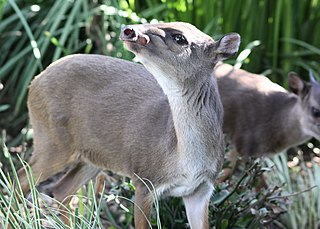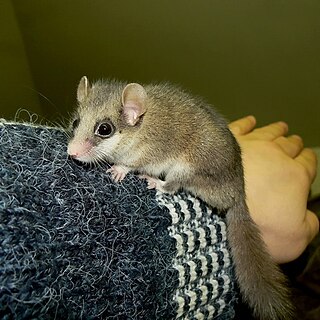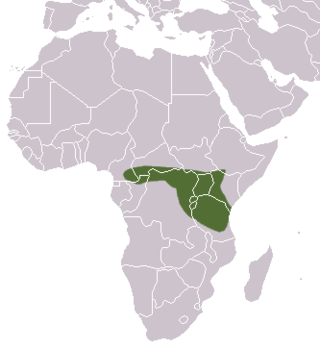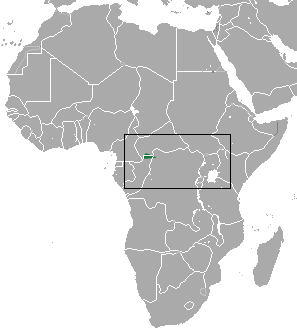
The blue duiker is a small antelope found in central, southern and eastern Africa. It is the smallest duiker. The species was first described by Swedish naturalist Carl Peter Thunberg in 1789. 12 subspecies are identified. The blue duiker reaches 32–41 centimetres (13–16 in) at the shoulder and weighs 3.5–9 kilograms (7.7–19.8 lb). Sexually dimorphic, the females are slightly larger than the males. The dark tail measures slightly above 10 centimetres (3.9 in). It has short, spiky horns, around 5 centimetres (2.0 in) long and hidden in hair tufts. The subspecies show a great degree of variation in their colouration. The blue duiker bears a significant resemblance to Maxwell's duiker.

The Angolan slender mongoose is a mongoose native to southwestern Africa, specifically southwestern Angola and northwestern Namibia. It has been listed as "Least Concern" on the IUCN Red List, as it is not threatened and thought to be common. It has a long, slim body and there are different colour forms, a black or dark brown form in the southern part of its range, and a yellowish- or reddish-brown form in the north. This mongoose inhabits dry, rocky habitats and feeds on insects, scorpions and small vertebrates.
The montane hylomyscus or montane wood mouse is a species of rodent in the family Muridae. A long-coated species with brownish-grey upper parts and whitish-grey underparts, it occurs in the uplands of tropical Central Africa where its natural habitat is tropical moist montane forests.
The Mount Oku hylomyscus is a species of rodent in the family Muridae. Found only on Mount Oku, Cameroon, in tropical Central Africa, its natural habitat is tropical moist montane forests. It has a very small range and is threatened by habitat destruction, so the International Union for Conservation of Nature has rated its conservation status as being "critically endangered".
The Mount Oku rat is a species of rodent in the family Muridae. The genus Lamottemys is monotypic, and this is the only species. It is found only in Cameroon where its natural habitat is subtropical or tropical moist montane forests. It is threatened by habitat destruction.
The Ethiopian forest brush-furred rat or golden-footed brush-furred rat, is a species of rodent in the family Muridae. It is endemic to Ethiopia where its natural habitat is subtropical or tropical moist montane forests. It is threatened by habitat loss.
Boehm's gerbil is a species of rodent found in Angola, Burundi, Democratic Republic of the Congo, Kenya, Malawi, Mozambique, Rwanda, Tanzania, Uganda, and Zambia. Its natural habitats are dry savanna, moist savanna, and arable land. This is a common species with a wide distribution which faces no obvious threats, so in 2004 the International Union for Conservation of Nature rated its conservation status as being of "least concern".

The dusky bushbaby is a species of primate in the family Galagidae. It is also known as Matschie's galago, in honour of the German zoologist Paul Matschie, curator of mammals at the Museum für Naturkunde in Berlin. Native to tropical Central Africa, it is found in forests in Burundi, Rwanda, Democratic Republic of the Congo and Uganda. The species is small with a long tail, and has an arboreal, nocturnal and omnivorous lifestyle.

The dwarf scaly-tailed squirrel is a species of rodent in the family Anomaluridae. It is found in Cameroon, Central African Republic, Republic of the Congo, Democratic Republic of the Congo, Equatorial Guinea, Gabon and Uganda. The species is nocturnal and arboreal and lives in subtropical or tropical lowland rainforest. Membranes attached to its limbs and tail enable it to glide between trees. This squirrel is currently not considered to be threatened by habitat destruction; "much of the habitat within parts of the known range of this species is relatively intact, and the species is unlikely to be experiencing any significant declines."
Thomas's rope squirrel or redless tree squirrel is a species of rodent in the family Sciuridae. It is found in Benin, Cameroon, Central African Republic, Democratic Republic of the Congo, Equatorial Guinea, Gabon, and Nigeria. Its natural habitat is subtropical or tropical moist lowland forests. It is a common species and the International Union for Conservation of Nature has rated it as being of "least concern".

The Lady Burton's rope squirrel is a species of rodent in the family Sciuridae. It is found in Cameroon, Central African Republic, Republic of the Congo, Equatorial Guinea, and Gabon. Its natural habitats are tropical and subtropical moist broadleaf forests and subtropical or tropical moist montane forest. It is a common species with a wide range, and the International Union for Conservation of Nature has rated it as being of "least concern".
Kellen's dormouse is a species of rodent in the family Gliridae. It is native to tropical Africa where its range extends from the Gambia and Senegal to Kenya and Tanzania. Its natural habitats are subtropical or tropical dry forests, and moist or dry savannah.

The woodland dormouse is a species of rodent in the family Gliridae. It is native to southern and eastern Africa and is also known as the African dormouse, African dwarf dormouse, African pygmy dormouse, or colloquially as micro squirrel. Found in limited numbers in the pet trade, it has complicated care requirements compared to other pet rodents. Its natural habitats are subtropical or tropical, moist montane forests and rivers.

The red-legged sun squirrel is a species of rodent in the family Sciuridae, also commonly known as the isabelline red-legged sun squirrel. It is native to tropical western and central Africa where its range extends from Senegal in the west, through Nigeria and the Republic of Congo to Uganda and Tanzania in the east. Its natural habitats are subtropical or tropical moist lowland forests and moist savanna. This species is thought to be common and has a very wide distribution, so the International Union for Conservation of Nature has rated its conservation status as being of "least concern".

The Zanj sun squirrel is a species of rodent in the family Sciuridae found in eastern Africa.

The forest giant squirrel or Stanger's squirrel is a species of rodent in the family Sciuridae found in Angola, Benin, Burundi, Cameroon, the Central African Republic, the Republic of the Congo, the Democratic Republic of the Congo, Ivory Coast, Equatorial Guinea, Gabon, Ghana, Kenya, Liberia, Nigeria, Rwanda, Sierra Leone, Tanzania, Togo, and Uganda. Its natural habitats are subtropical or tropical moist lowland forests and plantations.

Hildegarde's shrew is a species of mammal in the family Soricidae. It is found in Burundi, Cameroon, Central African Republic, Republic of the Congo, Democratic Republic of the Congo, Ethiopia, Kenya, Rwanda, and Tanzania. Considered by some authorities to be a subspecies of Crocidura gracilipes, it is now recognised as a separate species, with a diploid chromosome number of 2n = 52. This is one of three species of small mammal named by the British zoologist Oldfield Thomas in honour of anthropologist Hildegarde Beatrice Hinde.

The swamp musk shrew, or musk shrew, is a species of mammal in the family Soricidae. It occurs in Angola, Botswana, Democratic Republic of the Congo, Mozambique, Namibia, South Africa, Eswatini, Zambia and Zimbabwe. Its natural habitat is swamps, and it is a common species in suitable habitats, with the International Union for Conservation of Nature listing it as being of "least concern".

The Ugandan musk shrew is a species of mammal in the family Soricidae. It is found in Uganda, the Democratic Republic of Congo and the Central African Republic. Its range, population size and habits are poorly known.

The tantalus monkey is an Old World monkey from Africa that ranges from Ghana to Sudan. It was originally described as a subspecies of the grivet. All species in Chlorocebus were formerly in the genus Cercopithecus. It is a common species with a wide range, and the International Union for Conservation of Nature has rated its conservation status as being of "least concern".














